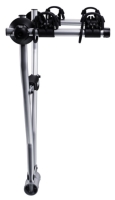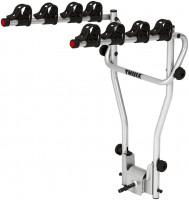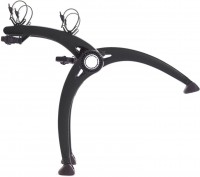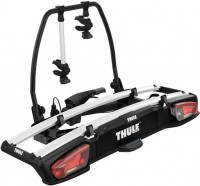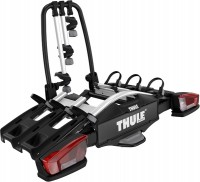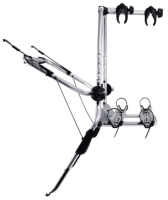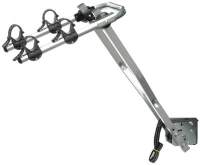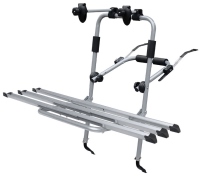Roof Boxes & Racks Thule
All models Advanced filters → |
You might be interested in
Roof Boxes & Racks: specifications, types
Type
— Open boot. The simplest kind of boot, which is a platform — most often not solid, but in the form of a set of parallel rails. Such a platform is installed on the crossbars (see "Installation"), and the transported cargo is fixed on it. The main advantage of open boots is the absence of restrictions on the height of transported items: it can be almost any (within reasonable limits, of course), the main thing is that the load capacity of the structure is enough. On the other hand, the load must be securely fastened — otherwise, at the slightest shock, it may simply fall out of the boot; and there is no talk of aerodynamics. In addition, the items transported in this way are absolutely not protected from external conditions. Because of this, when transporting delicate cargo, you will either have to choose favorable weather, or provide additional protection from rain, dust, etc. on their own.
— Boxing. A closed type of luggage carriers are containers that are usually installed on the crossbars on the roof. Most of the boxes are aerodynamically shaped (hence the variant of the name — "aeroboxes"), which reduces additional fuel consumption and noise levels. In addition, the closed design protects the contents from adverse external conditions, and also ensures that they do not fall out of the boot. Due to this, it is only necessary to secure the cargo in the box so that it does not hang around the cont...ainer (and with a dense load, the problem is solved by itself). The main disadvantage of such models is the limited volume, which does not allow transporting large items.
— Cross bars. Strictly speaking, the crossbars are not luggage carriers, but additional devices for installing various luggage carriers and mounts. They are rails that are placed, as the name implies, across the roof of the car — and additional devices can be mounted on these rails. The standard scope of supply includes two crossbars with fasteners; in some cases (in particular, when mounting on roof rails, see below), the distance between them can be adjusted, which makes it possible to adjust the design to different models of boots.
— Mount for skis / boards. A device for carrying skis or snowboards, usually on the roof of a car. In most cases, it has the form of paired mounts mounted on the front and rear cross members; each board or pair of skis is fixed at two points. It is more convenient to use specialized mounts for transporting such equipment than general-purpose boots.
— Bicycle rack. A special device that allows you to transport a bicycle (or several bicycles) without dismantling or folding. There are two main types of such mounts. The first option involves installation on the roof, on the crossbars, and the bike in this design is placed vertically along the car body. The second option is designed for mounting at the rear (on the door, tow bar or wheel) and for the transverse position of the load. Anyway, special mounts greatly simplify the transportation of bicycles, and the two-wheeled vehicles themselves are transported in working position and, after being removed from the car, can be used almost immediately, without special training.
— Mounting for boats. Devices for transporting boats — most often kayaks and canoes. Typically, such mounts are a pair of supports mounted on crossbars and shaped to match the bottom; the boat is placed on these stands and fixed with straps. There are other design options — for example, mounts for two kayaks, which involve the placement of boats on their side, relying on the side.
— Mount for surfing. Mounting for boards used in surfing. Some of these racks can also be used for other similar devices such as SUP boards, but this possibility should be specified separately.
— Mount for windsurfing. Fastening for boards used in windsurfing (surfing with a sail). Such boards are different from surfboards, respectively, and racks are different — they are designed for a larger size of the board, and also have a mount for the mast. In addition, such racks in most cases can be used for SUP boards (and some even have the word "SUP" in the name).
— Railing. Another type of auxiliary equipment designed to install boots or other devices. Actually, the roof rails look like a pair of rails, but they are installed along the car, usually directly on the body — for example, on gutters. After that, you can install a boot on such rails — or the same crossbars, and already fix the boot on them. Rails can be built-in, non-removable; But such equipment is not provided for in all cars. For this case, removable longitudinal rails are produced.
— Boxing. A closed type of luggage carriers are containers that are usually installed on the crossbars on the roof. Most of the boxes are aerodynamically shaped (hence the variant of the name — "aeroboxes"), which reduces additional fuel consumption and noise levels. In addition, the closed design protects the contents from adverse external conditions, and also ensures that they do not fall out of the boot. Due to this, it is only necessary to secure the cargo in the box so that it does not hang around the cont...ainer (and with a dense load, the problem is solved by itself). The main disadvantage of such models is the limited volume, which does not allow transporting large items.
— Cross bars. Strictly speaking, the crossbars are not luggage carriers, but additional devices for installing various luggage carriers and mounts. They are rails that are placed, as the name implies, across the roof of the car — and additional devices can be mounted on these rails. The standard scope of supply includes two crossbars with fasteners; in some cases (in particular, when mounting on roof rails, see below), the distance between them can be adjusted, which makes it possible to adjust the design to different models of boots.
— Mount for skis / boards. A device for carrying skis or snowboards, usually on the roof of a car. In most cases, it has the form of paired mounts mounted on the front and rear cross members; each board or pair of skis is fixed at two points. It is more convenient to use specialized mounts for transporting such equipment than general-purpose boots.
— Bicycle rack. A special device that allows you to transport a bicycle (or several bicycles) without dismantling or folding. There are two main types of such mounts. The first option involves installation on the roof, on the crossbars, and the bike in this design is placed vertically along the car body. The second option is designed for mounting at the rear (on the door, tow bar or wheel) and for the transverse position of the load. Anyway, special mounts greatly simplify the transportation of bicycles, and the two-wheeled vehicles themselves are transported in working position and, after being removed from the car, can be used almost immediately, without special training.
— Mounting for boats. Devices for transporting boats — most often kayaks and canoes. Typically, such mounts are a pair of supports mounted on crossbars and shaped to match the bottom; the boat is placed on these stands and fixed with straps. There are other design options — for example, mounts for two kayaks, which involve the placement of boats on their side, relying on the side.
— Mount for surfing. Mounting for boards used in surfing. Some of these racks can also be used for other similar devices such as SUP boards, but this possibility should be specified separately.
— Mount for windsurfing. Fastening for boards used in windsurfing (surfing with a sail). Such boards are different from surfboards, respectively, and racks are different — they are designed for a larger size of the board, and also have a mount for the mast. In addition, such racks in most cases can be used for SUP boards (and some even have the word "SUP" in the name).
— Railing. Another type of auxiliary equipment designed to install boots or other devices. Actually, the roof rails look like a pair of rails, but they are installed along the car, usually directly on the body — for example, on gutters. After that, you can install a boot on such rails — or the same crossbars, and already fix the boot on them. Rails can be built-in, non-removable; But such equipment is not provided for in all cars. For this case, removable longitudinal rails are produced.
Installation
The installation method for which the product is designed.
Modern luggage racks / air boxes can be installed in regular places(as an option: on gutters), on roof rails, on cross bars, behind a doorway(or a smooth roof), on a back door, on a spare wheel, on a tow bar or in a trailer. Here is a more detailed description of each of these options:
— Drip rails / fixed points. All models with this type of installation are placed on the roof, but specific placement methods may vary slightly. If the boot does not have a specialization for a specific car model (see “Regular boot for”), then it is attached to the gutters (characteristic gutters along the edges of the roof); in such cases, it is sufficient to have gutters on the car and match their shape to the shape of the boot mounts. In turn, regular models are installed on seats specially designed for boots; it is not necessarily a drain, although this option is very popular.
— On the rails. Roof rails are a pair of rails located along the roof, along its edges. In some cars, they are initially provided for in the design and made non-removable; for others, removable roof rails are available, which can also be sold separately (see "Type"). Anyway, the rails can ha...ve a different shape and location, so it will not be superfluous to clarify the compatibility of the boot with a specific car model.
— Behind the doorway / on a smooth roof. Option for cars not equipped with gutters (see above): special fasteners allow you to fix the boot directly on the door arches or other structural elements. The mounting configuration in such models can be different, often it is designed for a specific model (models) of a car; these points should be clarified separately.
— On the crossbars. Installation on cross members already attached to the car roof. Crossbars are usually purchased separately; see "Type" for details. And in the case of boots, this installation method is convenient because compatibility is practically independent of the car model — it is enough that the boot mounts match the existing rails in size and profile type (see below). On the other hand, the slats themselves usually involve installation on gutters, roof rails or a doorway (see above), with the corresponding selection hassle; and without crossbars, the boot will be useless.
— To the back door. Roof racks for station wagon and/or hatchback vehicles. The term "back door" in this case means the lid of the built-in boot in such a body; in fact, an external boot with this type of installation is attached behind the rear window. This method of transportation is very convenient for bicycles, so the rear door mount is found mainly in products of the corresponding type (see above).
— On the spare wheel. A method that is relevant mainly for SUVs / SUVs: in such cars, the spare wheel is often placed on the rear door (tailgate), and an external boot is attached to this wheel. Such accessories are in many ways similar to tailgate models — in particular, most of them are intended for bicycles.
— To the hitch. Mounting on a tow bar is a device originally designed for attaching a trailer to a car. The tow bar of a passenger car usually looks like a characteristic bracket with a so-called hitch ball; Luggage carriers with this type of fastening are designed for such designs. Most of these models are designed to carry bicycles (see "Type"), although there are exceptions; and for a normal installation, it is enough that the size of the coupling ball matches the size of the mount on the boot. This makes products with this type of installation very versatile.
— To the trailer. A rather specific type of boot, used mainly for carrying bicycles. Typically, such a device is based on a crossbar installed in an open trailer or other similar place — for example, the back of a pickup truck; and to transport a bicycle, you need to remove the front wheel from it and attach the fork to a special device on the crossbar. Such "boots" themselves are quite versatile, although compatibility with a specific car or trailer needs to be specified separately.
Modern luggage racks / air boxes can be installed in regular places(as an option: on gutters), on roof rails, on cross bars, behind a doorway(or a smooth roof), on a back door, on a spare wheel, on a tow bar or in a trailer. Here is a more detailed description of each of these options:
— Drip rails / fixed points. All models with this type of installation are placed on the roof, but specific placement methods may vary slightly. If the boot does not have a specialization for a specific car model (see “Regular boot for”), then it is attached to the gutters (characteristic gutters along the edges of the roof); in such cases, it is sufficient to have gutters on the car and match their shape to the shape of the boot mounts. In turn, regular models are installed on seats specially designed for boots; it is not necessarily a drain, although this option is very popular.
— On the rails. Roof rails are a pair of rails located along the roof, along its edges. In some cars, they are initially provided for in the design and made non-removable; for others, removable roof rails are available, which can also be sold separately (see "Type"). Anyway, the rails can ha...ve a different shape and location, so it will not be superfluous to clarify the compatibility of the boot with a specific car model.
— Behind the doorway / on a smooth roof. Option for cars not equipped with gutters (see above): special fasteners allow you to fix the boot directly on the door arches or other structural elements. The mounting configuration in such models can be different, often it is designed for a specific model (models) of a car; these points should be clarified separately.
— On the crossbars. Installation on cross members already attached to the car roof. Crossbars are usually purchased separately; see "Type" for details. And in the case of boots, this installation method is convenient because compatibility is practically independent of the car model — it is enough that the boot mounts match the existing rails in size and profile type (see below). On the other hand, the slats themselves usually involve installation on gutters, roof rails or a doorway (see above), with the corresponding selection hassle; and without crossbars, the boot will be useless.
— To the back door. Roof racks for station wagon and/or hatchback vehicles. The term "back door" in this case means the lid of the built-in boot in such a body; in fact, an external boot with this type of installation is attached behind the rear window. This method of transportation is very convenient for bicycles, so the rear door mount is found mainly in products of the corresponding type (see above).
— On the spare wheel. A method that is relevant mainly for SUVs / SUVs: in such cars, the spare wheel is often placed on the rear door (tailgate), and an external boot is attached to this wheel. Such accessories are in many ways similar to tailgate models — in particular, most of them are intended for bicycles.
— To the hitch. Mounting on a tow bar is a device originally designed for attaching a trailer to a car. The tow bar of a passenger car usually looks like a characteristic bracket with a so-called hitch ball; Luggage carriers with this type of fastening are designed for such designs. Most of these models are designed to carry bicycles (see "Type"), although there are exceptions; and for a normal installation, it is enough that the size of the coupling ball matches the size of the mount on the boot. This makes products with this type of installation very versatile.
— To the trailer. A rather specific type of boot, used mainly for carrying bicycles. Typically, such a device is based on a crossbar installed in an open trailer or other similar place — for example, the back of a pickup truck; and to transport a bicycle, you need to remove the front wheel from it and attach the fork to a special device on the crossbar. Such "boots" themselves are quite versatile, although compatibility with a specific car or trailer needs to be specified separately.
Standard for
The car model for which the boot is intended.
Products positioned as standard products can be produced both for a specific car model and for a specific line. Anyway, such a boot is better suited for a car than a universal model, because. its fastenings and shape, by definition, are optimized for a specific “seat”. On the other hand, finding a regular version is usually somewhat more difficult than a universal one, and such boots are not available for some brands at all.
Nowadays, on the market you can find, in particular, regular boots for cars from such manufacturers: Audi, BMW, Chevrolet, Citroen, Daewoo, Ford, Honda, Hyundai, KIA, Lada, Mazda, Mercedes-Benz, Mitsubishi, Nissan, Opel, Peugeot, Renault, Seat, Skoda, Subaru, Suzuki, SsangYong, Toyota, UAZ, Volkswagen.
Products positioned as standard products can be produced both for a specific car model and for a specific line. Anyway, such a boot is better suited for a car than a universal model, because. its fastenings and shape, by definition, are optimized for a specific “seat”. On the other hand, finding a regular version is usually somewhat more difficult than a universal one, and such boots are not available for some brands at all.
Nowadays, on the market you can find, in particular, regular boots for cars from such manufacturers: Audi, BMW, Chevrolet, Citroen, Daewoo, Ford, Honda, Hyundai, KIA, Lada, Mazda, Mercedes-Benz, Mitsubishi, Nissan, Opel, Peugeot, Renault, Seat, Skoda, Subaru, Suzuki, SsangYong, Toyota, UAZ, Volkswagen.
Load capacity
The maximum weight that is allowed to be carried on the boot.
It is definitely not worth exceeding this parameter — even if the structure does not break immediately, this can happen at any time due to off-design loads. And ideally, you should have some margin for carrying capacity — this will give an additional guarantee in case of emergency situations (like hitting a wheel in a hole at speed).
Also note that the weight of the intended load must be supported not only by the boot itself, but also by the crossbars on which it is installed (if this installation option is used, see above). Moreover, the weight of both the cargo and the boot falls on the crossbars, which requires an even greater margin for load for them.
As for specific carrying capacity indicators, in general, the indicator up to 50 kg is considered relatively low, 51 – 75 kg — average, 76 – 100 kg — above average, and in the most "heavy" models, the permissible load weight exceeds 100 kg.
It is definitely not worth exceeding this parameter — even if the structure does not break immediately, this can happen at any time due to off-design loads. And ideally, you should have some margin for carrying capacity — this will give an additional guarantee in case of emergency situations (like hitting a wheel in a hole at speed).
Also note that the weight of the intended load must be supported not only by the boot itself, but also by the crossbars on which it is installed (if this installation option is used, see above). Moreover, the weight of both the cargo and the boot falls on the crossbars, which requires an even greater margin for load for them.
As for specific carrying capacity indicators, in general, the indicator up to 50 kg is considered relatively low, 51 – 75 kg — average, 76 – 100 kg — above average, and in the most "heavy" models, the permissible load weight exceeds 100 kg.
Internal capacity
The internal volume of the closed boot — boxing (see "Type").
Along with the load capacity (see above), this parameter determines the amount of cargo that can be placed in the boot. At the same time, we note that more load-bearing models generally have a more extensive interior space; however, products of a similar "weight category" may differ markedly in this indicator. And here it is worth proceeding from the fact that with the same allowable weight, a more voluminous boot is better suited for light and/or bulky goods, but it will have more weight, dimensions and price, and also (with a high probability) create additional resistance during movement, especially at high speed.
As for specific values, most modern boxes have a capacity in the range of 400 – 500 liters. A volume of 300 – 400 liters or less is considered relatively small, more than 500 liters — large.
Along with the load capacity (see above), this parameter determines the amount of cargo that can be placed in the boot. At the same time, we note that more load-bearing models generally have a more extensive interior space; however, products of a similar "weight category" may differ markedly in this indicator. And here it is worth proceeding from the fact that with the same allowable weight, a more voluminous boot is better suited for light and/or bulky goods, but it will have more weight, dimensions and price, and also (with a high probability) create additional resistance during movement, especially at high speed.
As for specific values, most modern boxes have a capacity in the range of 400 – 500 liters. A volume of 300 – 400 liters or less is considered relatively small, more than 500 liters — large.
Opening
The parameter determines from how many sides the boot is accessed (see "Type"). From a practical point of view, the choice on the opening side depends on who most often needs access to the contents of the boot. For example, it is most convenient for the driver to get the content from the left-side boot – since the steering wheel is usually located on the left, you do not have to go around the car to open the container. For the same reason, the right-side opening will be optimal for the passenger in the front seat. That is why most of the models have a -two-side opening. One-sided boots mostly have an opening on the left. For full versatility, a rear opening is also provided — in boots with a three-side opening. But this is a very rare and not much in demand option.
Number of bike
The number of bikes that the dedicated carrier is designed for (see "Type").
For each bike in such mounts, a seat is provided, so the number of bicycles transported is strictly limited. Note that roof racks (on roof rails, crossbars, etc. — see "Installation") are usually designed for only 1 bike, but in rear-mounted models (on the back door, tow bar, etc.) .) there are solutions for 2 places and even more.
For each bike in such mounts, a seat is provided, so the number of bicycles transported is strictly limited. Note that roof racks (on roof rails, crossbars, etc. — see "Installation") are usually designed for only 1 bike, but in rear-mounted models (on the back door, tow bar, etc.) .) there are solutions for 2 places and even more.
Bicycle mounting type
Mounting method provided in bicycle racks (see "Type")
- Frame. Mount to the frame, or more precisely, to the top cross member of a classic bicycle frame. A fairly simple, convenient and reliable option, which, however, may not be suitable for some bicycles - in particular, models with a “female” low frame.
— Wheel/frame. Attachment to the wheel(s) and frame at the same time. Thanks to additional fastening points, this option provides greater reliability than the frame-only mounting described above. In addition, the design may provide for the possibility of adjusting the fastening to non-standard frames (however, this possibility must be clarified separately).
- Wheels. Mount only by the wheel(s) is quite rare - mainly among bicycle racks installed on the roof. The effectiveness of such fasteners does not depend on the type of frame, however, the device may be incompatible with small diameter wheels.
— Front fork. Mount for the front wheel fork; The wheel itself must be removed. This option is used in some bike racks mounted in a trailer (see “Installation”) - it is easier to place a bicycle with a removed wheel in a trailer/body than a fully assembled one.
- Frame. Mount to the frame, or more precisely, to the top cross member of a classic bicycle frame. A fairly simple, convenient and reliable option, which, however, may not be suitable for some bicycles - in particular, models with a “female” low frame.
— Wheel/frame. Attachment to the wheel(s) and frame at the same time. Thanks to additional fastening points, this option provides greater reliability than the frame-only mounting described above. In addition, the design may provide for the possibility of adjusting the fastening to non-standard frames (however, this possibility must be clarified separately).
- Wheels. Mount only by the wheel(s) is quite rare - mainly among bicycle racks installed on the roof. The effectiveness of such fasteners does not depend on the type of frame, however, the device may be incompatible with small diameter wheels.
— Front fork. Mount for the front wheel fork; The wheel itself must be removed. This option is used in some bike racks mounted in a trailer (see “Installation”) - it is easier to place a bicycle with a removed wheel in a trailer/body than a fully assembled one.
Skis number
The number of pairs of skis for which the luggage rack is designed.
Note that such mounts are available not only in specialized models (see "Type") — boxes are also available with the possibility of transporting skis. As for the number of clamps, the skis take up relatively little space, so up to 4 inclusive is a relatively small number of pairs of skis for a modern boot. Models for 5 – 6, or even 7 – 8 pairs are noticeably more common, and in some products this number may exceed 8.
Note that such mounts are available not only in specialized models (see "Type") — boxes are also available with the possibility of transporting skis. As for the number of clamps, the skis take up relatively little space, so up to 4 inclusive is a relatively small number of pairs of skis for a modern boot. Models for 5 – 6, or even 7 – 8 pairs are noticeably more common, and in some products this number may exceed 8.
Lock
The presence of a lock in the design of the boot.
Almost all modern boxes are equipped with locks (see "Type"), and in such models the purpose of this function is obvious: it protects the contents from theft and unauthorized access. However, similar equipment can be provided in other types of luggage carriers and even in cross members; in the latter case, the lock is used to prevent an unauthorized person from removing the rails with the boot installed on them. Anyway, the presence of a lock provides additional security.
Also note that theoretically, the lock can be any (coded, electronic, etc.), however, in fact, classical devices that are opened and closed with a key are most often used.
Almost all modern boxes are equipped with locks (see "Type"), and in such models the purpose of this function is obvious: it protects the contents from theft and unauthorized access. However, similar equipment can be provided in other types of luggage carriers and even in cross members; in the latter case, the lock is used to prevent an unauthorized person from removing the rails with the boot installed on them. Anyway, the presence of a lock provides additional security.
Also note that theoretically, the lock can be any (coded, electronic, etc.), however, in fact, classical devices that are opened and closed with a key are most often used.
Material
The main material used in the construction of the boot. For boxes (see "Type"), the material of the container is indicated here, for crossbars — the material of the rails, etc.
— Steel. The main advantages of steel are high strength and reliability; in addition, the price of this material is low. There is also a drawback: steel structures are quite heavy, which accordingly affects fuel consumption. At the same time, the difference in weight with aluminium analogues is usually not so great that this disadvantage can be considered critical.
— Aluminium. Most of the aluminium alloys used in modern boots combine good strength and corrosion resistance with low weight (the latter helps save fuel). However such structures are more expensive than steel ones.
— Plastic. Plastic is characterized by low cost, combined with good strength, corrosion resistance, ease of processing and low weight. In terms of reliability, it is somewhat inferior to metals, but this moment becomes significant only at high loads. Therefore, plastic is practically not used in crossbars and open boots (see "Type"), but it is quite suitable for other types — except, perhaps, for the most load-bearing models.
— Fibreglass. Material based on glass threads. Unlike ordinary glass, such threads do not break or break, but instead are able to bend easily. The fibreglass used in car boots is notable for its high strength and low weight, but it is also quite expensive, and...therefore is found mainly among premium models.
— Textile. The fabric is mainly used for boxes (see "Type"). Such products have a soft container that resembles a tourist backpack (and the fabric itself usually belongs to the “tourist” varieties — nylon or polyester). The main advantage of this material is the ability to roll an unused boot into a fairly compact roll; and the weight of the structure is quite small. On the other hand, in terms of aerodynamic properties and degree of protection, soft boxes lose out to hard ones, and this material is practically inapplicable in other types of boots.
— Steel. The main advantages of steel are high strength and reliability; in addition, the price of this material is low. There is also a drawback: steel structures are quite heavy, which accordingly affects fuel consumption. At the same time, the difference in weight with aluminium analogues is usually not so great that this disadvantage can be considered critical.
— Aluminium. Most of the aluminium alloys used in modern boots combine good strength and corrosion resistance with low weight (the latter helps save fuel). However such structures are more expensive than steel ones.
— Plastic. Plastic is characterized by low cost, combined with good strength, corrosion resistance, ease of processing and low weight. In terms of reliability, it is somewhat inferior to metals, but this moment becomes significant only at high loads. Therefore, plastic is practically not used in crossbars and open boots (see "Type"), but it is quite suitable for other types — except, perhaps, for the most load-bearing models.
— Fibreglass. Material based on glass threads. Unlike ordinary glass, such threads do not break or break, but instead are able to bend easily. The fibreglass used in car boots is notable for its high strength and low weight, but it is also quite expensive, and...therefore is found mainly among premium models.
— Textile. The fabric is mainly used for boxes (see "Type"). Such products have a soft container that resembles a tourist backpack (and the fabric itself usually belongs to the “tourist” varieties — nylon or polyester). The main advantage of this material is the ability to roll an unused boot into a fairly compact roll; and the weight of the structure is quite small. On the other hand, in terms of aerodynamic properties and degree of protection, soft boxes lose out to hard ones, and this material is practically inapplicable in other types of boots.
External dimensions (LxWxH)
Boot dimensions in working position; usually indicated for open models and boxes (see "Type"). The capacity of the product directly depends on this parameter, in particular, its suitability for transporting large items. And in the case of boxes, dimensions also affect aerodynamics: increasing the height or width increases drag and fuel consumption. At the same time, it should be noted that the aerodynamics of the container also largely depends on its shape.
For open boots, the height is most often not indicated — after all, its actual value usually depends not on the dimensions of the structure, but on the size of the cargo being transported.
For open boots, the height is most often not indicated — after all, its actual value usually depends not on the dimensions of the structure, but on the size of the cargo being transported.
Weight
Net weight of the boot in working (fully assembled) form.
The light weight contributes to fuel economy (especially during long-term use) and also makes it easier to transport the boot outside the car (for example, from storage to the car and back). On the other hand, lightening the product leads either to a decrease in its strength and load capacity, or to an increase in cost. So in certain situations, a relatively heavy boot may be the best choice; and when choosing a light model, you should pay special attention to the claimed load capacity.
The light weight contributes to fuel economy (especially during long-term use) and also makes it easier to transport the boot outside the car (for example, from storage to the car and back). On the other hand, lightening the product leads either to a decrease in its strength and load capacity, or to an increase in cost. So in certain situations, a relatively heavy boot may be the best choice; and when choosing a light model, you should pay special attention to the claimed load capacity.
Mounting kit
A variety of fasteners that are equipped with cross members (see "Type").
- Regular. Regular kits are designed for a specific brand of car or for a specific list of models, in which the "seats" for the crossbars are almost identical. The scope of use of such kits is limited to "native" cars, but for these cars they are better suited than universal ones.
- Universal. Mounts that are not designed for any particular brand of car and are suitable for any car that has "seats" of the desired size and shape. Such kits, despite the name, are not absolutely universal, their compatibility with a particular car must be specified separately. The scope of their application is usually wider than that of regular ones, however, the reliability of the installation may be lower.
- Regular. Regular kits are designed for a specific brand of car or for a specific list of models, in which the "seats" for the crossbars are almost identical. The scope of use of such kits is limited to "native" cars, but for these cars they are better suited than universal ones.
- Universal. Mounts that are not designed for any particular brand of car and are suitable for any car that has "seats" of the desired size and shape. Such kits, despite the name, are not absolutely universal, their compatibility with a particular car must be specified separately. The scope of their application is usually wider than that of regular ones, however, the reliability of the installation may be lower.
Profile
The shape of the profile of the rails used in the cross members(see "Type").
— Rectangular. Reiki, having a rectangular shape in section with clearly defined corners. They are easier to manufacture than aerodynamic ones, and, accordingly, cheaper, but they have a higher drag — this affects the noise level and, to some extent, fuel consumption.
— Aerodynamic. Profile designed to reduce air resistance. The specific form of such cross-sections may be different; nowadays, oval and teardrop-shaped designs are most common. In the first case, the profile has a symmetrical or almost symmetrical shape; it is easier to manufacture and, accordingly, is somewhat cheaper. The teardrop profile, in turn, has a thickening in the front and narrows towards the back; its advantage is rather high efficiency. However, anyway, the aerodynamic shape of the rails reduces air resistance, and, accordingly, the noise level and fuel consumption. The flip side of these advantages is the rather high cost.
— Rectangular. Reiki, having a rectangular shape in section with clearly defined corners. They are easier to manufacture than aerodynamic ones, and, accordingly, cheaper, but they have a higher drag — this affects the noise level and, to some extent, fuel consumption.
— Aerodynamic. Profile designed to reduce air resistance. The specific form of such cross-sections may be different; nowadays, oval and teardrop-shaped designs are most common. In the first case, the profile has a symmetrical or almost symmetrical shape; it is easier to manufacture and, accordingly, is somewhat cheaper. The teardrop profile, in turn, has a thickening in the front and narrows towards the back; its advantage is rather high efficiency. However, anyway, the aerodynamic shape of the rails reduces air resistance, and, accordingly, the noise level and fuel consumption. The flip side of these advantages is the rather high cost.
Height adjustment
The ability to change the height of the crossbars (see "Type") on the mount.
This feature is found mainly in a rather specific type of crossbar — products designed for cars with an elevated roof (mainly minibuses). The height adjustment allows you to optimally adjust the structure to the height of this roof. On the other hand, adjustable mounts significantly affect the cost of the crossbars and reduce their reliability, and on conventional cars this feature is unnecessary. Therefore, there are very few models with this function nowadays.
This feature is found mainly in a rather specific type of crossbar — products designed for cars with an elevated roof (mainly minibuses). The height adjustment allows you to optimally adjust the structure to the height of this roof. On the other hand, adjustable mounts significantly affect the cost of the crossbars and reduce their reliability, and on conventional cars this feature is unnecessary. Therefore, there are very few models with this function nowadays.
Crossbars length
The length of the crossbars (see "Type") included in the scope of supply. If the slats are of different lengths, both sizes are specified in this paragraph; if one number is indicated here, this means that the size of both crossbars is the same.
Anyway, the length of the crossbars must be no less than the distance between the attachment points of each of them (for example, between the left and right railing) — otherwise the size of the rail is simply not enough to block the space from one point to another. But the margin for this indicator is quite acceptable: most models have the ability to adjust the exact distance between the mounts (at least within a few centimeters). However, for a full guarantee, the range of such adjustment and compatibility with a specific car is still desirable to clarify separately.
Anyway, the length of the crossbars must be no less than the distance between the attachment points of each of them (for example, between the left and right railing) — otherwise the size of the rail is simply not enough to block the space from one point to another. But the margin for this indicator is quite acceptable: most models have the ability to adjust the exact distance between the mounts (at least within a few centimeters). However, for a full guarantee, the range of such adjustment and compatibility with a specific car is still desirable to clarify separately.

